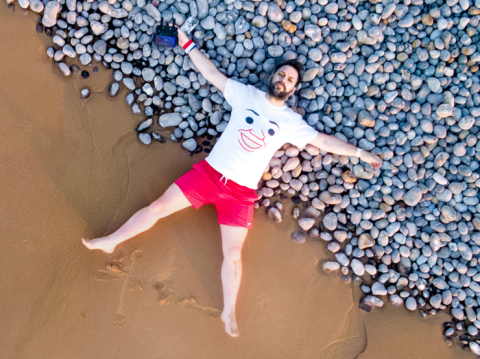Ctrl + Shift + Career: How I switched industries, found illustration, and made 500 Meeples along the way
- Brew Digital
- Illustration
My career path into design is, perhaps, a little unconventional. I had previously worked for close to 20 years in the movies industry (I have probably served you overpriced popcorn or ice cream, if you’re a local of Norwich), while drawing, painting, and photoshopping in my downtime. Hoping it might lead somewhere, I spent a year on an unofficial, one-day-a-week internship — and in 2019, was offered my first proper design job, at that agency. Apparently they didn’t mind me hanging about once a week for a year!
As a fresh-faced, largely self-taught 40-something—very junior—designer, I mostly supported my lead by recreating internal web pages, based on structures they'd created. I also designed logos and icons, and it was here that I discovered a passion for illustration.
After such a huge career change, I was happy to finally have a foot in the creative door— it had taken a long time getting here. But then Covid-19 arrived, and I suddenly found myself working from home, then furloughed, and ultimately unemployed.
It had been a whirlwind, but thankfully the ride wasn’t over. A well-placed friend encouraged me to contact Brew Digital and after three nervous Zoom interviews (another new experience) I was delighted to be offered a job: the first one I had applied for post-pandemic.
In the beginning
I thought I’d be tasked with similar tasks to that in my last agency, which would have been fine. However, and I guess in keeping with Brew Digital’s ethos of not being your typical digital marketing agency, I was pleasantly surprised to be thrown into the deep-end of learning the illustration style of our biggest client: Adaptavist.
I started with a few smaller projects, namely refined spot images. These are used in tight spaces to convey a message in a more compact way. A mistake I made at the beginning was perhaps adding too much detail to these, but in no time, I was able to distil ideas into their simplest form.
Soon I got stuck-in on creating full meeple scenes. (Meeple is the collective term for the characters featured in Adaptavist illustrations). Their styling was still relatively new, following a slight brand refresh, so it was a good time to join and help build their little world—and my confidence.
We use a design aesthetic called Corporate Memphis, which you will have almost certainly seen before—especially in the technology and SaaS sectors. To be honest, the aesthetic probably warrants a blog of its own, but the name derives from the Memphis Group (a bunch of Italian designers and architects from the '80s) who inspired a movement with their bold colours and geometric shapes. Anyway, I digress…
This visual identity entails heavily stylised people (meeple) collaborating and/or interacting with props and, in our case, technology. A key consideration for us was to balance professionalism with warmth and personality, attempting an equilibrium between not too stiff, not too cartoony.
Adaptavist’s meeples are built from a shared library of modular parts—like heads, hands, poses, and props - enabling a repeatable, flexible structure that supports quick iteration. The perspective is isometric and the characters are simple but expressive. Three is the magic number, with figures typically arranged in a triangle for visual balance, though compositions often feature one, two, or three meeples depending on the context.
A style sheet provided clear guidance on the meeple illustrations, covering colour palette, body proportions, shadows, and lighting effects. These creative constraints help ensure consistency across the brand while also encouraging the kind of lateral thinking needed to visualise complex or abstract ideas. Colour plays an important role with cool blues representing the actors, while warm oranges highlight the focal point, whether that’s a tool, object, or concept. Soft shadows and subtle gradients add just enough depth to keep things feeling warm and human without distracting from the message
Finding my rhythm
It’s important to remember all the while that working within a visual language should serve function as well as form. And that's precisely why I love illustrations; they're not just about aesthetics, they're about communication. They provide an at-a-glance snapshot relevant to the content they accompany.
They help visualise the often invisible and guide the viewer, enhancing accessibility in the process. The use of meeple, for instance, not only adds warmth to the brand but also encourages a human connection—it's what we like to call the mascot effect. Illustrations also support consistency across all platforms. They're adaptable (pun intended) and scalable, making them a versatile tool in the world of design. Plus, they're a smart alternative to photography, saving time and money whilst still adding that essential polish.
Cmd + Option + Zoom Out
Moving into agency design work has been a shift, certainly, but not as stark as you might think. After nearly two decades working in a cinema, I’d spent plenty of time thinking about how stories are framed, how people are guided through visual experiences, and how light, colour, and composition shape what we feel. In a way, trading projection booths for design briefs was less of a leap and more of a reframing. In my time at Brew Digital, I conservatively estimate to have made over 500 Adaptavist illustrations. The tools may have changed, but the instinct to direct the eye, set the tone, and build emotional clarity remained. From movie screen to computer screen, it’s still about helping people connect with something just out of reach.
Finally, a quick shout-out to the excellent brand guardians, Brendan and Dan. They taught me everything I needed to know in trying circumstances, remotely during lockdown. I will always appreciate their humour, time and patience.
Thank you for reading my first ever blog.
Kerry, aged 48 and a half.




